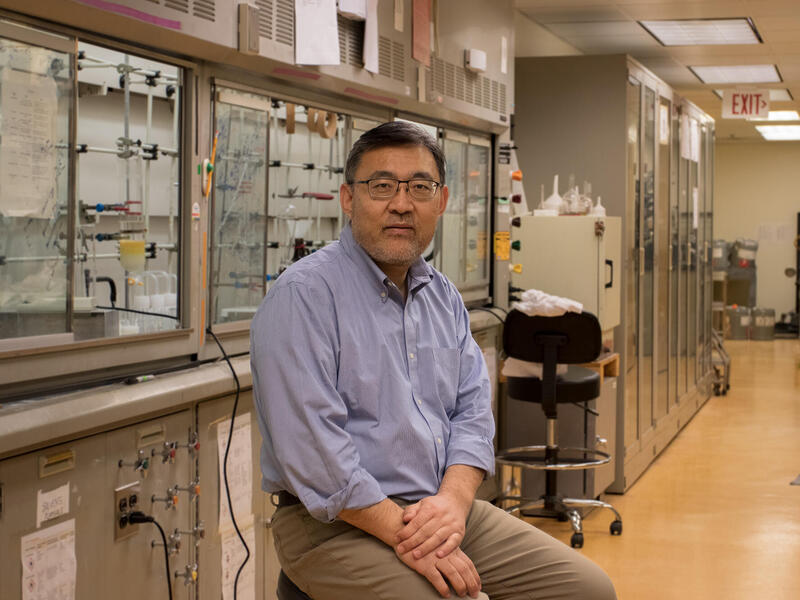
March 31, 2025
At the huge Consumer Electronics Show, a tiny innovation from VCU gets a spotlight
Share this story
Held every January, the renowned Consumer Electronics Show in Las Vegas is spread across hundreds of thousands of square feet. And while the latest gadgetry – phones, entertainment systems, wearable devices and more – from famous brands grab the spotlight, don’t overlook the less-traveled exhibition halls that showcase less-visible technologies.
In these spaces, engineers and designers explore the components found inside of those everyday devices. And it was here, in booth 61305 at this year’s CES, where a company called Seta Connectivity spotlighted one of the latest creations from a Virginia Commonwealth University faculty-researcher: tiny antennas that could have a huge impact.
The devices are one in a portfolio of technologies from Supriyo Bandyopadhyay, Ph.D., a professor in the College of Engineering’s Department of Electrical and Computer Engineering and in the College of Humanities and Sciences’ Department of Physics. He is on the cutting edge of developing next-generation, low-power “nano-antennas,” which could change how many communication devices are built and used.
“This work has the potential to revolutionize multiple industries — like medical implants that communicate via electromagnetic waves and never need a battery replacement, to ultra-efficient on-chip wireless communication systems to stealth devices for defense and crime-fighting,” Bandyopadhyay said. “We are breaking fundamental limitations in antenna design to make devices smaller, smarter and more energy-efficient. This could redefine how we connect and interact with technology in the future.”
As communication devices requiring antennas get smaller, traditional antennas can’t keep up because the more they shrink, the weaker and less efficient they become.
Some science: Bandyopadhyay’s nano-antenna overcomes size limitations by using magnetic waves (called spin waves) and acoustic waves to create radio signals. The interplay takes place across a tiny magnet atop a piezoelectric material, a substance that reacts when an electric field is applied. When activated by the nanomagnet’s spin waves, an acoustic wave is created, which generates the antenna signal.
Bandyopadhyay has authored numerous papers on his intellectual property, which caught the attention of Canadian startup foundry and incubator TandemLaunch. The firm specializes in identifying promising technologies, building a roadmap to commercialize them and developing a company from the ground up.
“We scout for inventions from universities around the world that we believe can solve some of the world’s long-term challenges or disrupt existing incumbent technologies,” said Omar Zahr, Ph.D., the company’s chief technology officer and principal.
TandemLaunch also recruits a team of founders and puts technical and product leadership in place to help develop a standalone company. Through his work with VCU TechTransfer and Ventures, which helps commercialize on-campus innovations, Bandyopadhyay forged a partnership with TandemLaunch, which spun out a company based on his IP called Seta Connectivity.
Established in 2023, the collaboration aims to commercialize Bandyopadhyay’s nano-antenna designs — much smaller than a fingernail, highly efficient and capable of “beam steering” to change the direction of the waves, a feat typically requiring large phased arrays of dozens of antennas.

“We can demonstrate beam steering with a single antenna that is several orders of magnitude smaller than a phased array,” Bandyopadhyay says.
The partnership is a major boost for Bandyopadhyay’s portfolio, said Brent Fagg, TechTransfer and Ventures’ assistant director for innovation who is managing the IP.
“The plan is for Seta to design and outline the manufacturing process of the antenna chip, then sell the designs to manufacturers and customers to produce them,” Fagg said.
The idea of using “acousto-electric” technology to address the size constraints of antennas had appeared in scientific journals a few years before TandemLaunch engaged with VCU.
“At the time, the concept didn’t seem ready for market,” Zahr said, “so we kept an eye on the area because we saw the potential.”
Then the company found an academic paper from Bandyopadhyay.
“In order for this concept to work, you have to perform a sequence of energy transformations across the piezoelectric substrate, and Supriyo figured out how to do so and not lose a lot of energy along the way,” Zahr said. “So that was really the innovation for us. His findings mean that you can achieve the specifications necessary for the industry to use the concept. It’s his intelligence and intuition in equal parts about how to manipulate energy across the surface of a chip that led to this outcome.”
Hanie Kazari, Ph.D., product development lead at TandemLaunch and Seta, said Bandyopadyhay’s designs “made some smart tweaks that made his technology different from everything else we’d seen.” Now, she said, Seta is taking those designs “from lab to fab.”
In fabrication, Seta must confirm that what is built in the Monroe Park Campus laboratory of Bandyopadhyay’s College of Engineering collaborator, professor and Senior Associate Dean Erdem Topsakal, Ph.D., can be constructed the same way in a factory hundreds of miles away and millions of times over.
“The risks are, can this be fabricated at scale? The way it was made in the lab is not particularly scalable, so we had to look at other methods of micro-electrical mechanical manufacturing,” Zahr said. “The second challenge: What is the market entry strategy for this? Which industry segment has the highest pressure for requiring an antenna this small?”
The initial answer goes back to that booth at this year’s CES: The team is starting its exploration with Bluetooth antennas, found in most communications and medical devices.
“We had several major companies stopping by and also had several requests for the samples,” said Kazari, who staffed the event. “There was even interest from industries that I personally didn’t think about. We can see the real potential of producing a new standard for antenna design out of this innovation.”
Subscribe to VCU News
Subscribe to VCU News at newsletter.vcu.edu and receive a selection of stories, videos, photos, news clips and event listings in your inbox.










